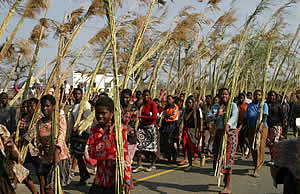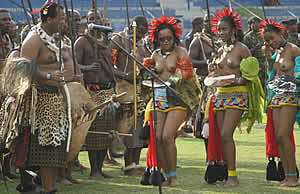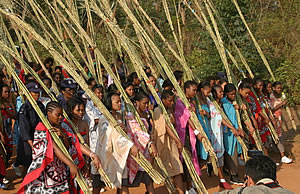

|
|
eSWATINI (SWAZILAND) CULTURE AND TRADITIONS
|
||||||||||
GENERAL INFORMATIONhttps://en.wikipedia.org/wiki/Culture_of_Swaziland The culture of Swazi people involves music, food, religion, architecture, kinship among many othe things.[1] The Swazi people are composed of various Nguni clans who speak the Nguni language SiSwati.
The Ngwenyama is considered the head of the nation alongside the Ndlovukati who is the spiritual leader of the nation.
National cultural events often involve the Ngwenyama or Ndlovukati. At home, the patriach of the family is the head and in the past, often practiced polygamy. This headman, usually referred to as umnumzane is central to all activities of the home.
A group of homes forming a community and the land they reside on forms a chiefdom or umphakatsi. Several chiefdoms form an inkhundla which then belongs of a regional division of the country. This connects the older traditional leadership structures to more modern forms of government.
There are national cultural events such as umhlanga, emaganu and incwala which take place at Royal residences of the Ngwenyama and Ndlovukati. Local cultural events in communities or imiphakatsi, take place at the residence of the chief also called emphakatsini. Weddings, funerals and religious events are usually carried out at family homesteads where neighbors are usually invited to partake.
SANGOMA, INYHANGA – TRADITIONAL HEALERS OF eSWATINI (SWAZILAND)
Inyanga performs rituals that are common to that of a “sangoma”. The role of a “sangoma” is to find the cause of misfortune or disease. The “sangoma” prescribes actions to rectify the misfortune or in the case of illness, prepares medication to cure illnesses. They are more accurately described as “which finders” as apposed to the European misinterpretation and given the epithet “which doctor”. To learn the craft, learners “tangoma”, (plural of “sangoma”) attend various “schools” and undergo “lutfwasa”, a learning process which may take up to a year or longer. About a dozen or more learners are resident at a small homestead of Bethany, headed by LaMabuza which is situated near Matsapha in central eSwatini (Swaziland). During this learning process, the learners will have to observe various taboos: no sexual relations, no quarreling, and no shaking hands among others.
“Throwing of the bones” (“ematsambo”), is a collection of small bones, a variety of other small objects like dice, beads etc which are thrown on a mat and depending upon the way the objects and bones fall, a solution to the problem can then be divined. During “indumba” the small house that is the learners base, there would be drumming and they will enter in a trance, grunting and sweating dance to the drums and communicate the message of the “emadloti” (ancestral spirit). A red cloth is draped over their shoulders, the drum rhythm changes to that of “emaNdzawe” (or Ndau which is people living in Mozambique or Zimbabwe), This is done because in past history, a group of Swazi’s marauding in the area had come across some cattle belonging to those of “emaNdzawe”, they had been instructed not to kill the cows as they were to be offered as a sacrifice to the ancestral spirits.
The Swazi’s killed the people daring to oppose them as well as the cattle. As a result thereof, the “emandawe” spirits have haunted them and therefore, they require being placated in these ceremonies. The “tangoma” would speak with a strangled voice in a language that was said to be an old form of “Ndau”, a language only known to them when in a trace, and shake vigorously to the rhythm of the drums. Through dreams and vision that are interpreted by another “sangoma” as indicating a normal person has a calling to become a diviner. Although the calling is more than often resisted because a “sangoma” is distinguished by her appearance with her hair in “siyendle” style, decorated with traditional medicine, small bottles and subject to many taboos. In eSwatini (Swaziland) there are far more woman “tangoma” than men. The calling becomes irresistible and hence she becomes a learner ‘sangoma.
The student learns to use the traditional medication “umutsi” and the ceremonies that are associated with that. These medicines consist of mainly roots and ground bark but can contain animal parts as well. Some rituals performed include medicine put in water in clay pots, stirred with a special stick that it forms a froth of which a small amount is then eaten and applied to their face and on top of their head. During the two day ceremony which is called “kuphotfulwa” the candidate is initiated as a fully qualified “sangoma” as they have now completed their “iNtfwasa” training.
A herbalist “Inyanga” (plural: tinyanga) does not perform rituals that are common to a “sangorma” Herbalists often have a large variety of “umutsi” which are traditional medicines kept in artistically carved vessels. The men’s costumes of the “inyanga”, especially if they are from outside the country, may also be different. UMTSIMBA – THE SWAZI LOBOLA, WEDDING CEREMONY AND DISSOULUTIONLobola negotiations can be long and complex. The main purpose of Lobolo is to determine the worth of the bride. Often during the negotiations either a bottle of brandy or traditional sorghum beer is placed on the table which is not usually drunk. This gesture is known as “imvulamlomo” which means “mouth opener”. The purpose of this tradition is to make everyone feel welcome.
The potential wife’s delegation decides whether the alcohol will be consumed or not. The amount is affected by many different factors and the circumstances of the bride to be. Lobolo is considered customary in Swazi marriages and the purpose thereof is to build relations between the prospective families. In the event of death of either spouse the marriage is then dissolved. Should the wife leave her husband as a result of abuse, the husband may have to pay a fine to the father or if the wife refuses to return then the husband can make a claim against the Lobola. If the wife initiates a divorce, the father will have to repay some of the Lobola.
The wedding ceremony takes place over several days which includes seven stages and is called “umtsimba”. The first stage is the preparation of the bridal party, the second stage is the journey of the bridal party. The third stage is the first day of the wedding ceremony and lasts three days. The fourth stage is when the actual wedding ceremony takes place and is known as “umtsimba”.
The fifth stage is known as “kuteka, this is the actual wedding and the final stage is when gifts are given by the bride to the groom’s family. In the final stage it is the first time that the bride actually gets to spend the first evening with the groom and husband and wife. The wedding ceremony and functions include traditional beer called “umcombotsi”. Traditional attire is worn and during the functions gifts of sweets, coins, and fruits are given by the audience to the dancers. Many traditions and rituals are followed during the wedding ceremony during the various stages.
After the wedding ceremony is completed, only then is the Lobola transferred, however this can take months or years after the ceremony. The Swazi tradition states: “akulotjolwa intfombi kulotjolwa umfati” which when translated means: the bride price is paid for a woman who is legally bound in marriage and not for a single woman.
THE REED DANCE |
||||||||||

 |

 |
|
|||||||||||||||